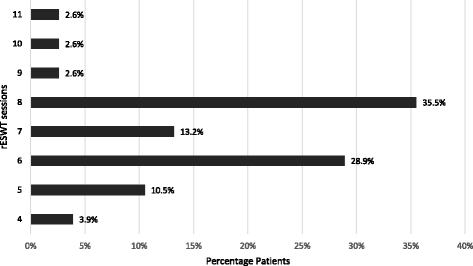Individualised radial extracorporeal shock wave therapy (rESWT) for symptomatic calcific shoulder tendinopathy: a retrospective clinical study
- PMID: 29207984
- PMCID: PMC5718020
- DOI: 10.1186/s12891-017-1873-x
Individualised radial extracorporeal shock wave therapy (rESWT) for symptomatic calcific shoulder tendinopathy: a retrospective clinical study
Abstract
Background: A retrospective single centre cohort analysis was performed to evaluate an individualised radial extracorporeal shock wave therapy (rESWT) protocol for treatment of symptomatic calcific shoulder tendinopathy.
Methods: 67 patients (79 Shoulders) were identified with 76 shoulders included for analysis. rESWT treatment protocol was adapted according to individual response to treatment. Variables included number of sessions, shockwave impulses, pressure and frequency. Success rate was estimated as the percentage of patients having ≥60% visual analogue score (VAS) pain decrease at follow-up. Recurrence at 1 year was recorded.
Results: Using this individualised symptom guided protocol, patients underwent a mean of 7 ± 1.5 rESWT sessions, with mean pressure of 1.7 ± 0.2 bar, mean frequency of 5 ± 0.3 Hz and 2175 ± 266 impulses. The mean pre-treatment VAS score of 6.7 ± 1.1 was significantly decreased to 3.2 ± 0.8 immediately post-treatment, 2.6 ± 0.9 at 1 month, 1.7 ± 1.0 at 3 months and 0.8 ± 1.0 at 1 year follow up (α = 0.05). One-year success rate was estimated at 92% and 1-year recurrence rate was 7%.
Conclusions: We conclude that in this retrospective study an individualised rESWT protocol resulted in a high success rate with low number of recurrences. Randomised controlled trials to support these findings are recommended.
Keywords: ESWT; Radial extracorporeal shockwave therapy; Recurrence rate; Symptomatic shoulder calcifying tendinopathy; Treatment.
Conflict of interest statement
Ethics approval and consent to participate
Ethical approval for this retrospective cohort analysis was granted by the Thessaloniki Clinic Institutional Review Board (ART No 2012–04). All participants provided written informed consent.
Consent for publication
Not applicable.
Competing interests
H Lohrer received research support and was a paid speaker from Storz Medical. The other authors declare that there is no conflict of interests regarding the publication of this paper.
Publisher’s Note
Springer Nature remains neutral with regard to jurisdictional claims in published maps and institutional affiliations.
Figures
References
MeSH terms
Supplementary concepts
LinkOut - more resources
Full Text Sources
Other Literature Sources
Medical



